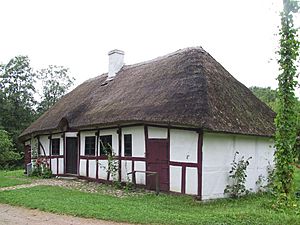Whitewash facts for kids
Whitewash is a special kind of paint. You might also hear it called calcimine or lime paint. It's used to make surfaces look bright white and clean. People have used whitewash for thousands of years on homes and other buildings.
Contents
What is Whitewash Made Of?
Whitewash is mainly made from two simple ingredients:
- Slaked lime: This is also known as calcium hydroxide. It's a white powder that comes from limestone.
- Chalk: This is a type of calcium carbonate. It helps make the paint smooth and white.
When these are mixed with water, they create a paint that dries to a bright, matte finish.
Why Use Whitewash?
People use whitewash for several reasons:
- To make things white: It gives walls and other surfaces a fresh, clean, white look.
- To protect surfaces: It can help protect buildings from weather and wear.
- For cleanliness: Whitewash can make surfaces look very neat and tidy. It's often used on farms or in places where hygiene is important.
- To keep cool: In hot climates, white surfaces reflect sunlight. This helps keep buildings cooler inside.
What Else Can Be Added?
Sometimes, other things are added to whitewash to change how it works or looks. These additions can include:
- Water glass (sodium silicate)
- Glue or egg white
- Portland cement
- Salt or soap
- Milk or flour
- Even soil
People also added different materials to change the color of whitewash. For example, some historical recipes used pig's blood to make it pink. Blue laundry dye was sometimes added to give it a blue tint.
Where is Whitewash Used?
Whitewash is used both inside and outside buildings. You can see it on:
- The outside walls of houses, especially in warm countries.
- The inside walls of homes, barns, and other structures.
- Fences, trees, and other outdoor objects.
It's a simple, natural, and often inexpensive way to paint and protect surfaces.
Images for kids
-
White-painted trees in Turkey
See also
 In Spanish: Encalado para niños
In Spanish: Encalado para niños






